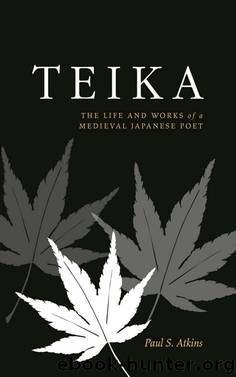Teika by Atkins Paul S

Author:Atkins, Paul S.
Language: eng
Format: epub
Publisher: University of Hawaii Press
Published: 2017-01-15T00:00:00+00:00
Notes
1. Reizei-ke Shiguretei Bunko, ed., Godai kan’yō, Teika kagaku, vol. 37, Reizei-ke Shiguretei sōsho (Tokyo: Asahi Shinbunsha, 1996) provides photographs of twelve texts in the Reizei archive. There is one version of Maigetsushō included, but it is not in Teika’s hand.
2. In compiling the list of texts, I have consulted a range of primary texts, secondary scholarship, and reference material. The most important sources are Imai Akira, Kanechiku Nobuyuki, Karazawa Masami, and Kusano Takashi, “Fujiwara no Teika chosaku ichiran,” in Waka Bungaku Kai, ed., Ronshū Fujiwara no Teika (Tokyo: Kasama Shoin, 1988), pp. 295–355, and Kamijō Shōji, “Kaidai,” in Godai kan’yō, Teika kagaku, ed. Reizei-ke Shiguretei Bunko, pp. 3–105.
3. For an annotated, typeset edition, see Hisamatsu Sen’ichi and Nishio Minoru, eds., Karonshū, nōgakuronshū, vol. 65, Nihon koten bungaku taikei (Tokyo: Iwanami Shoten, 1961), pp. 99–111. For an English translation, see Robert H. Brower and Earl Miner, trans., Fujiwara Teika’s “Superior Poems of Our Time”: A Thirteenth-Century Poetic Treatise and Sequence (Stanford, CA: Stanford University Press, 1967). French translations of Kindai shūka, Eiga no taigai, and Maigetsushō are included in Michel Vieillard-Baron’s study of Teika’s poetics, Fujiwara no Teika, 1162–1241, et la notion d’excellence en poésie: théorie et pratique de la composition dans le Japon classique (Paris: Collège de France, Institut des Hautes Études Japonaises, 2001).
4. For English translations, see Wm. Theodore de Bary, Donald Keene, George Tanabe, and Paul Varley, eds., Sources of Japanese Tradition from Earliest Times to 1600, 2nd ed. (New York: Columbia University Press, 2001), vol. 1, pp. 203–204; Hiroaki Satō, trans., An Outline for Composing Tanka, in From the Country of Eight Islands: An Anthology of Japanese Poetry, ed. Hiroaki Satō and Burton Watson (Seattle: University of Washington Press, 1981), pp. 202–204; and Lewis Cook, trans., “Essentials of Poetic Composition” in Traditional Japanese Literature: An Anthology, Beginnings to 1600, ed. Haruo Shirane (New York: Columbia University Press, 2007), pp. 605–607. For an annotated, typeset edition, see Hisamatsu Sen’ichi and Nishio Minoru, eds., Karonshū, nōgakuronshū, vol. 65, Nihon koten bungaku taikei (Tokyo: Iwanami Shoten, 1961), pp. 114–115.
5. For an annotated, typeset edition, see Kubota Jun, ed., “Kyōgoku chūnagon sōgo,” in Karonshū, ed. Hisamatsu Sen’ichi (Tokyo: Miyai Shoten, 1971), vol. 1, pp. 331–338.
6. For an annotated, typeset edition, see Kubota Jun, ed., Kinugasa naifu no uta no nanji, in Karonshū, vol. 1, Chūsei no bungaku series, ed. Hisamatsu Sen’ichi (Tokyo: Miyai Shoten, 1971), pp. 287–295.
7. For an annotated, typeset edition, see Nakagawa Hiroo, ed., Shin chokusen wakashū, vol. 6, Waka bungaku taikei (Tokyo: Meiji Shoin, 2005), pp. 3–5. Annotated excerpts of the anthology (but not the preface) appear in Inoue Muneo, ed., Chūsei wakashū, vol. 49, Shinpen Nihon koten bungaku zenshū (Tokyo: Shōgakukan, 2000), pp. 149–157.
8. For an annotated, typeset edition, see Hirata Hideo, Mimosusogawa utaawase, Miyagawa utaawase shinchū (Tokyo: Seikansha, 2012), pp. 93–175; Inoue Muneo, Chūsei wakashū, pp. 51–88.
9. For an annotated, typeset edition and commentary, see Watanabe Yumiko, Shin kokin jidai no hyōgen hōhō (Tokyo: Kasama Shoin, 2010), pp. 187–256. A photograph of the unnumbered round
Download
This site does not store any files on its server. We only index and link to content provided by other sites. Please contact the content providers to delete copyright contents if any and email us, we'll remove relevant links or contents immediately.
| African | Asian |
| Australian & Oceanian | Canadian |
| Caribbean & Latin American | European |
| Jewish | Middle Eastern |
| Russian | United States |
4 3 2 1: A Novel by Paul Auster(11049)
The handmaid's tale by Margaret Atwood(6852)
Giovanni's Room by James Baldwin(5878)
Big Magic: Creative Living Beyond Fear by Elizabeth Gilbert(4723)
Asking the Right Questions: A Guide to Critical Thinking by M. Neil Browne & Stuart M. Keeley(4574)
On Writing A Memoir of the Craft by Stephen King(4213)
Ego Is the Enemy by Ryan Holiday(3991)
Ken Follett - World without end by Ken Follett(3972)
The Body: A Guide for Occupants by Bill Bryson(3801)
Bluets by Maggie Nelson(3710)
Adulting by Kelly Williams Brown(3670)
Guilty Pleasures by Laurell K Hamilton(3586)
Eat That Frog! by Brian Tracy(3514)
White Noise - A Novel by Don DeLillo(3435)
The Poetry of Pablo Neruda by Pablo Neruda(3367)
Alive: The Story of the Andes Survivors by Piers Paul Read(3310)
The Bookshop by Penelope Fitzgerald(3226)
The Book of Joy by Dalai Lama(3217)
Fingerprints of the Gods by Graham Hancock(3212)
